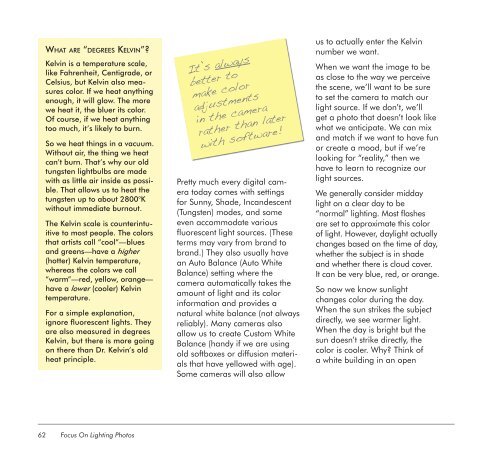Focus On Lighting Photos Focus on the Fundamentals.pdf
You also want an ePaper? Increase the reach of your titles
YUMPU automatically turns print PDFs into web optimized ePapers that Google loves.
62<br />
what are “degrees KeLvin”?<br />
Kelvin is a temperature scale,<br />
like Fahrenheit, Centigrade, or<br />
Celsius, but Kelvin also measures<br />
color. If we heat anything<br />
enough, it will glow. The more<br />
we heat it, <strong>the</strong> bluer its color.<br />
Of course, if we heat anything<br />
too much, it’s likely to burn.<br />
So we heat things in a vacuum.<br />
Without air, <strong>the</strong> thing we heat<br />
can’t burn. That’s why our old<br />
tungsten lightbulbs are made<br />
with as little air inside as possible.<br />
That allows us to heat <strong>the</strong><br />
tungsten up to about 2800°K<br />
without immediate burnout.<br />
The Kelvin scale is counterintuitive<br />
to most people. The colors<br />
that artists call “cool”—blues<br />
and greens—have a higher<br />
(hotter) Kelvin temperature,<br />
whereas <strong>the</strong> colors we call<br />
“warm”—red, yellow, orange—<br />
have a lower (cooler) Kelvin<br />
temperature.<br />
For a simple explanati<strong>on</strong>,<br />
ignore fluorescent lights. They<br />
are also measured in degrees<br />
Kelvin, but <strong>the</strong>re is more going<br />
<strong>on</strong> <strong>the</strong>re than Dr. Kelvin’s old<br />
heat principle.<br />
<str<strong>on</strong>g>Focus</str<strong>on</strong>g> <str<strong>on</strong>g>On</str<strong>on</strong>g> <str<strong>on</strong>g>Lighting</str<strong>on</strong>g> <str<strong>on</strong>g>Photos</str<strong>on</strong>g><br />
It’s always<br />
better to<br />
make color<br />
adjustments<br />
in <strong>the</strong> camera<br />
ra<strong>the</strong>r than later<br />
with software!<br />
Pretty much every digital camera<br />
today comes with settings<br />
for Sunny, Shade, Incandescent<br />
(Tungsten) modes, and some<br />
even accommodate various<br />
fluorescent light sources. (These<br />
terms may vary from brand to<br />
brand.) They also usually have<br />
an Auto Balance (Auto White<br />
Balance) setting where <strong>the</strong><br />
camera automatically takes <strong>the</strong><br />
amount of light and its color<br />
informati<strong>on</strong> and provides a<br />
natural white balance (not always<br />
reliably). Many cameras also<br />
allow us to create Custom White<br />
Balance (handy if we are using<br />
old softboxes or diffusi<strong>on</strong> materials<br />
that have yellowed with age).<br />
Some cameras will also allow<br />
us to actually enter <strong>the</strong> Kelvin<br />
number we want.<br />
When we want <strong>the</strong> image to be<br />
as close to <strong>the</strong> way we perceive<br />
<strong>the</strong> scene, we’ll want to be sure<br />
to set <strong>the</strong> camera to match our<br />
light source. If we d<strong>on</strong>’t, we’ll<br />
get a photo that doesn’t look like<br />
what we anticipate. We can mix<br />
and match if we want to have fun<br />
or create a mood, but if we’re<br />
looking for “reality,” <strong>the</strong>n we<br />
have to learn to recognize our<br />
light sources.<br />
We generally c<strong>on</strong>sider midday<br />
light <strong>on</strong> a clear day to be<br />
“normal” lighting. Most flashes<br />
are set to approximate this color<br />
of light. However, daylight actually<br />
changes based <strong>on</strong> <strong>the</strong> time of day,<br />
whe<strong>the</strong>r <strong>the</strong> subject is in shade<br />
and whe<strong>the</strong>r <strong>the</strong>re is cloud cover.<br />
It can be very blue, red, or orange.<br />
So now we know sunlight<br />
changes color during <strong>the</strong> day.<br />
When <strong>the</strong> sun strikes <strong>the</strong> subject<br />
directly, we see warmer light.<br />
When <strong>the</strong> day is bright but <strong>the</strong><br />
sun doesn’t strike directly, <strong>the</strong><br />
color is cooler. Why? Think of<br />
a white building in an open



